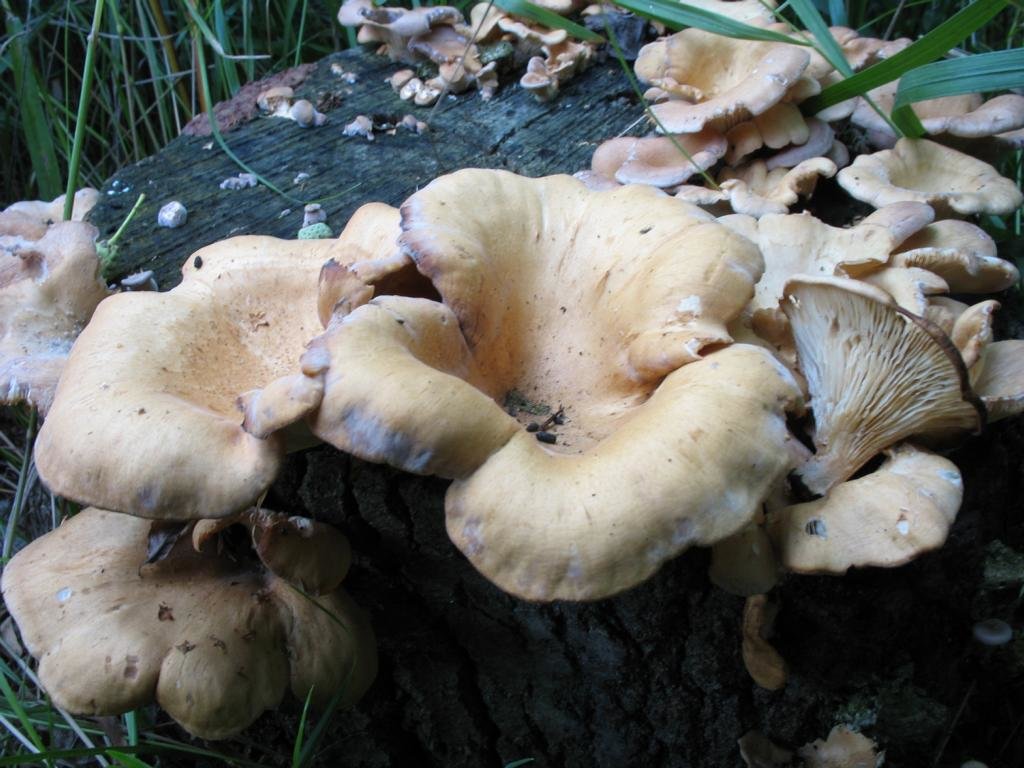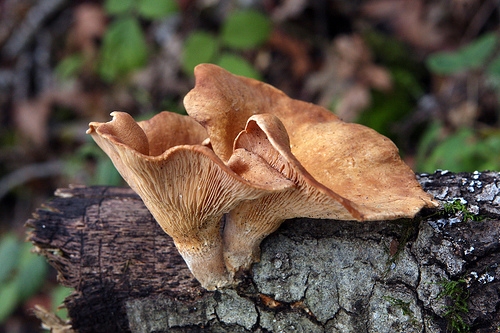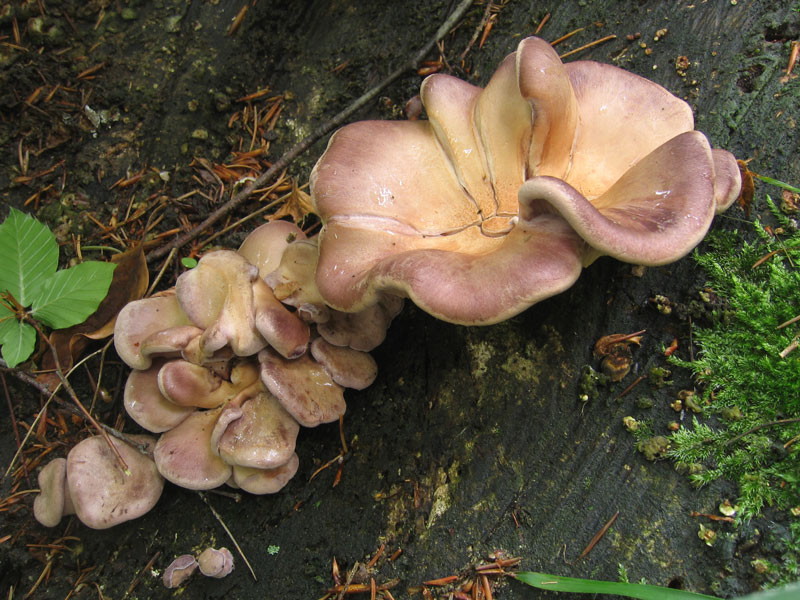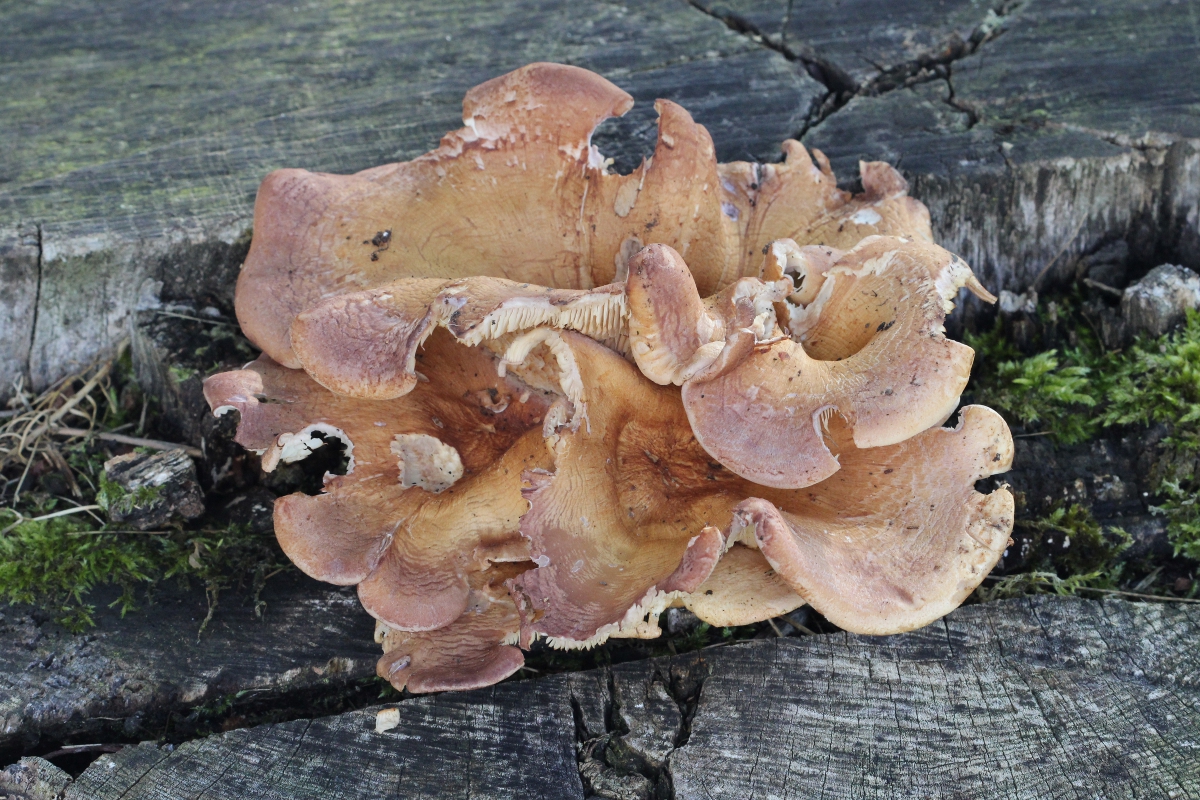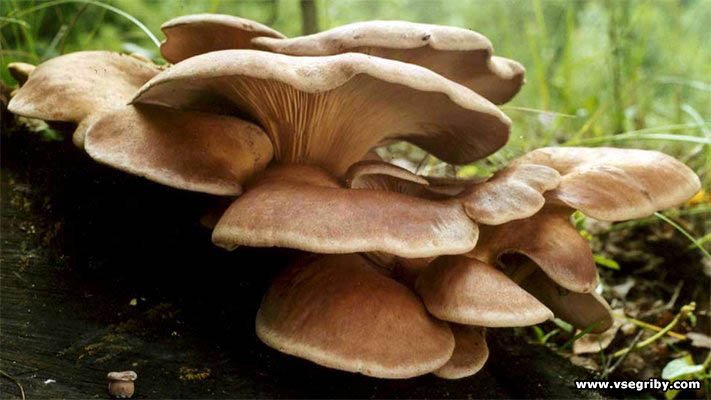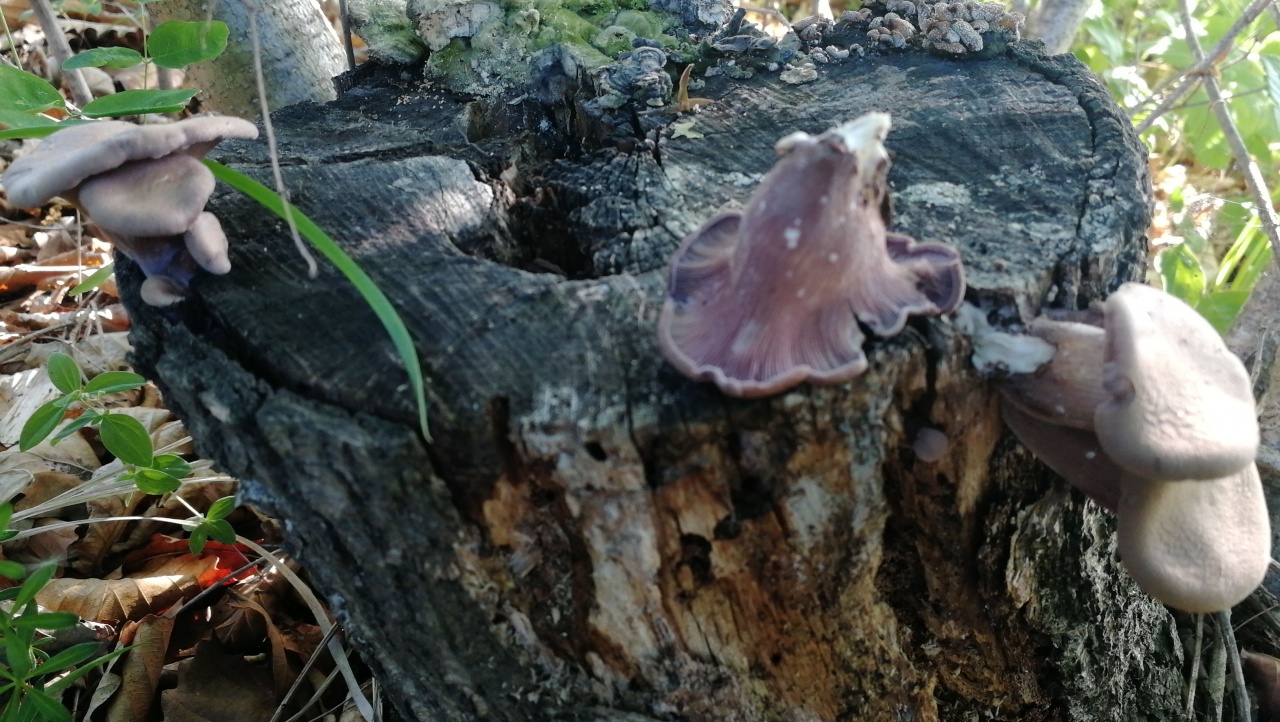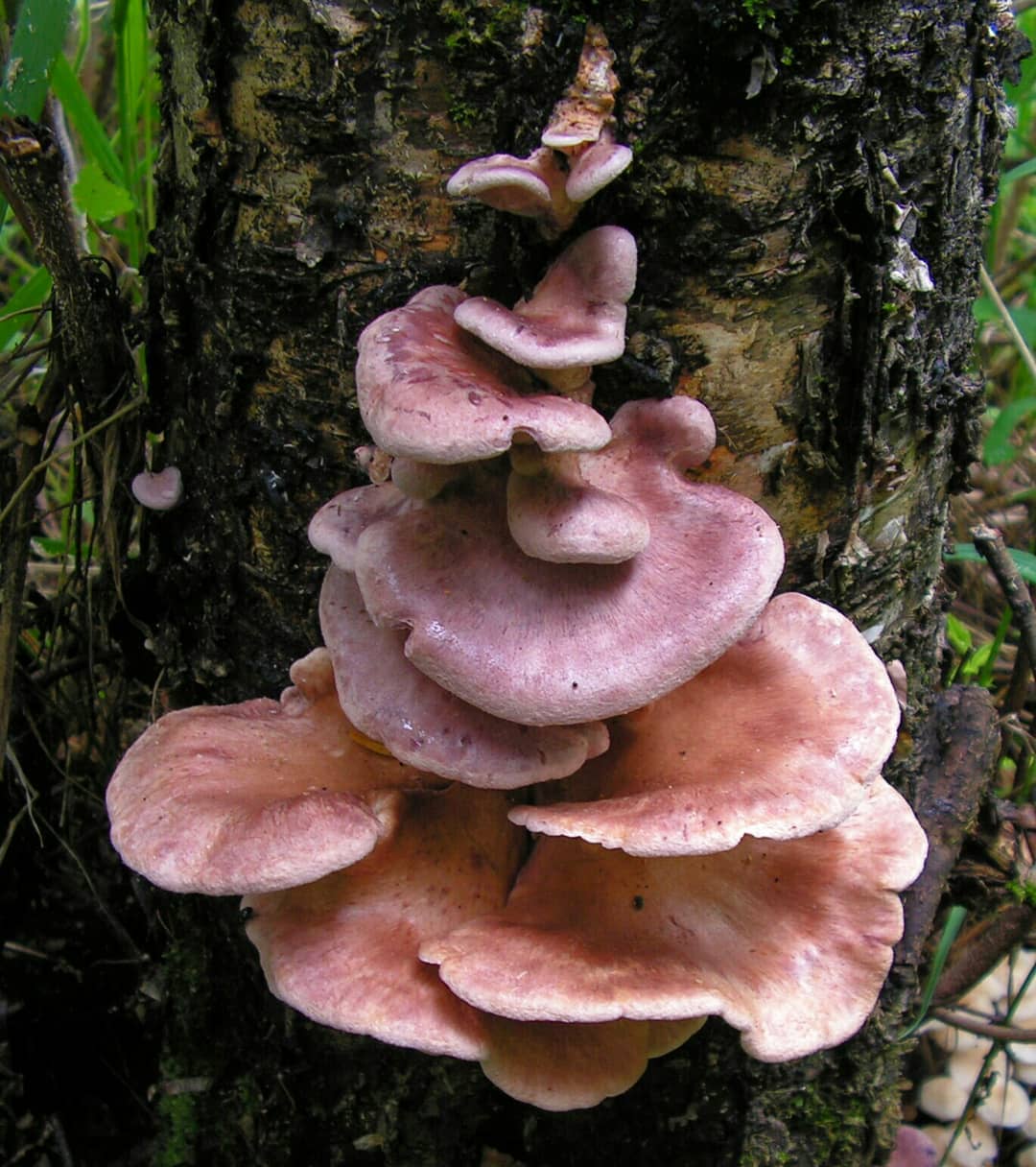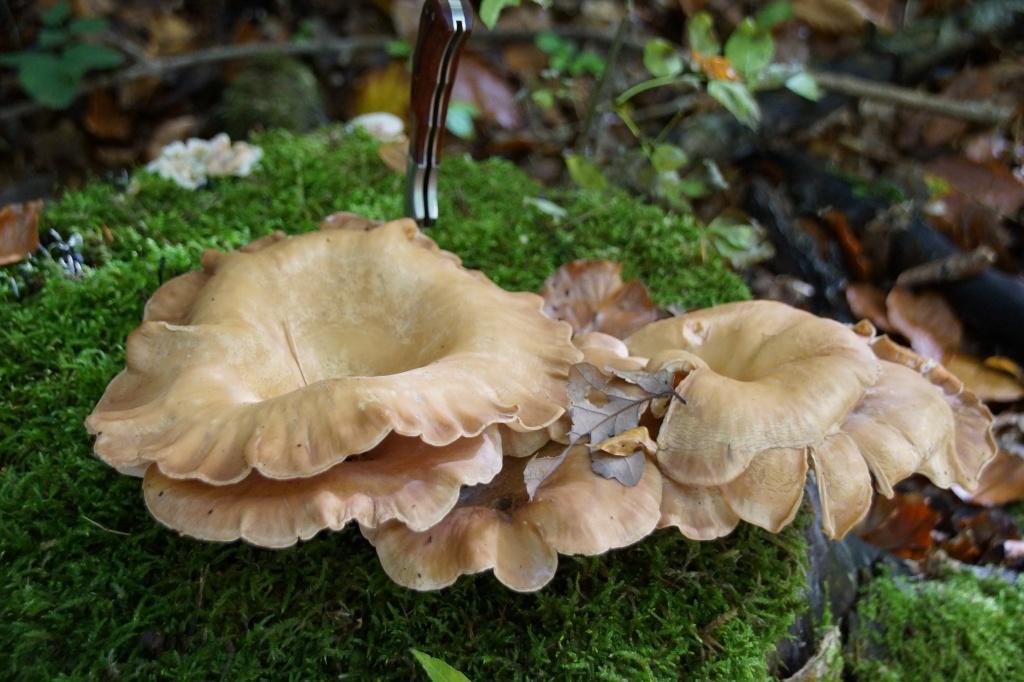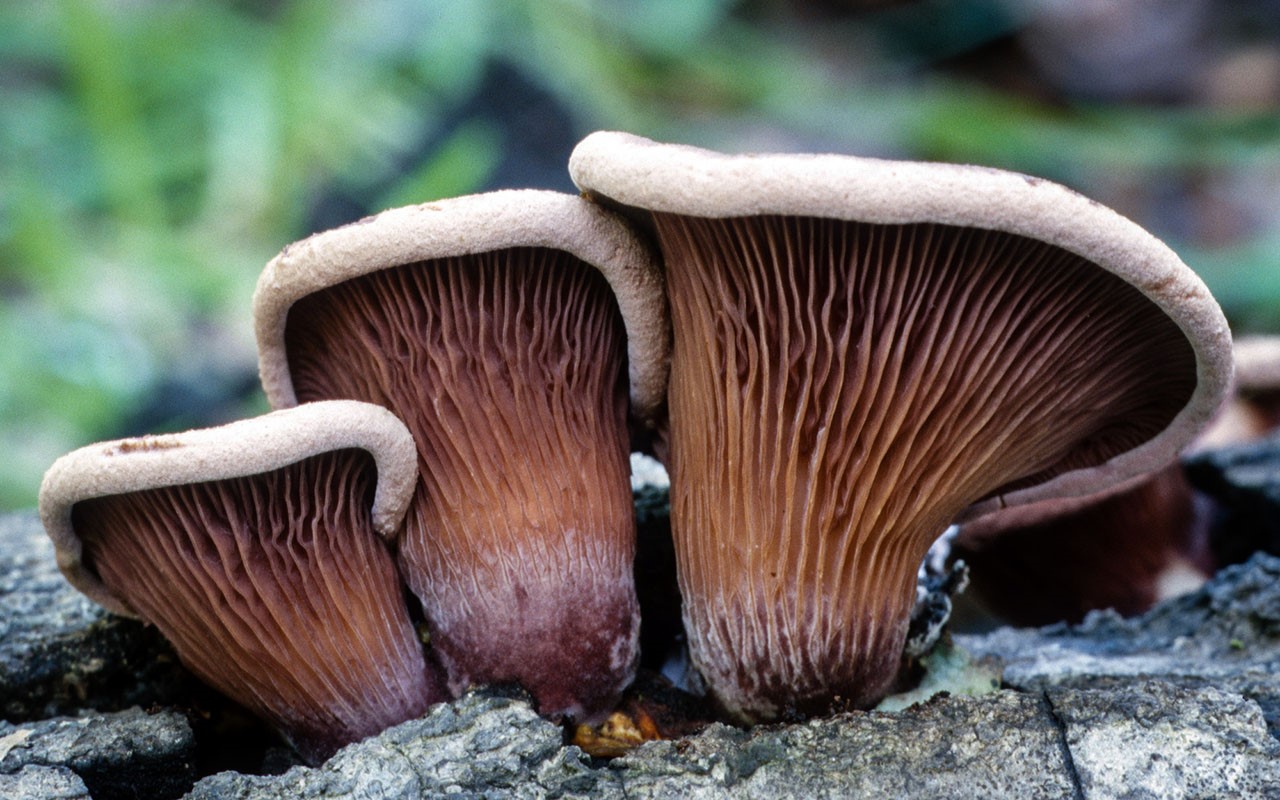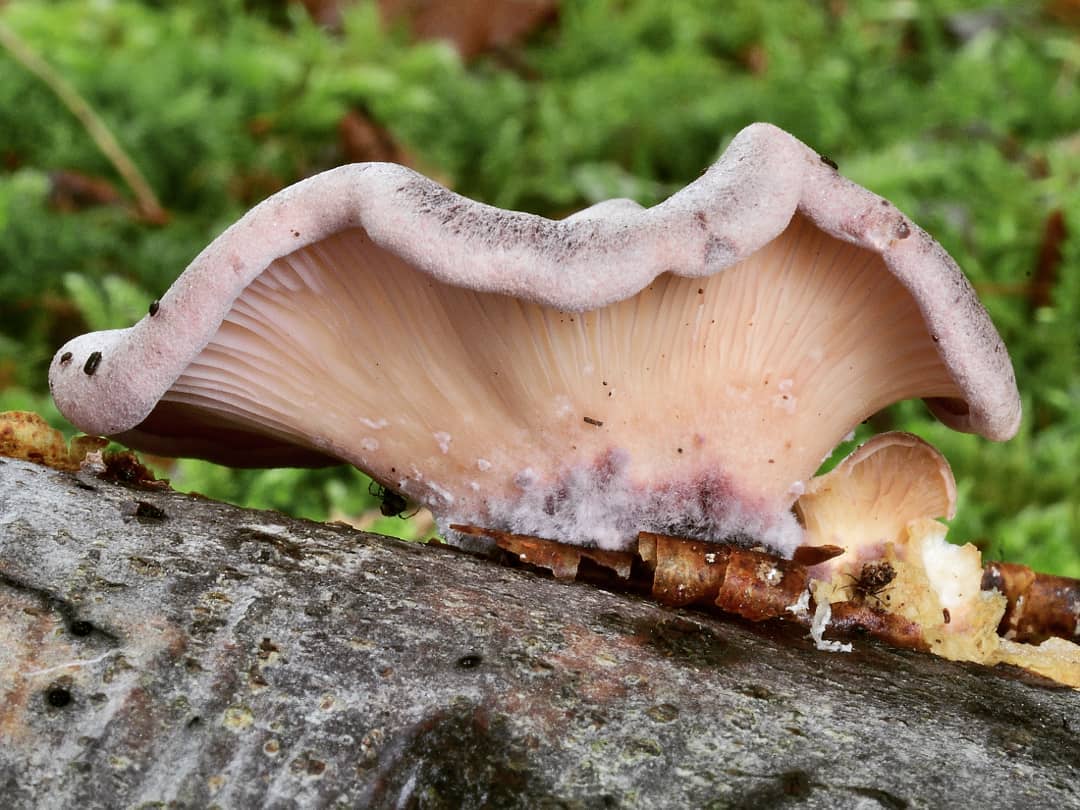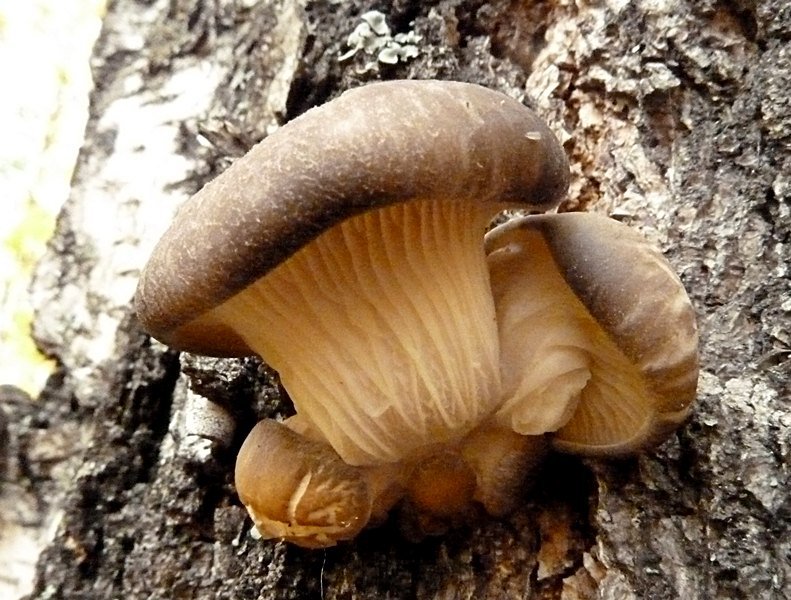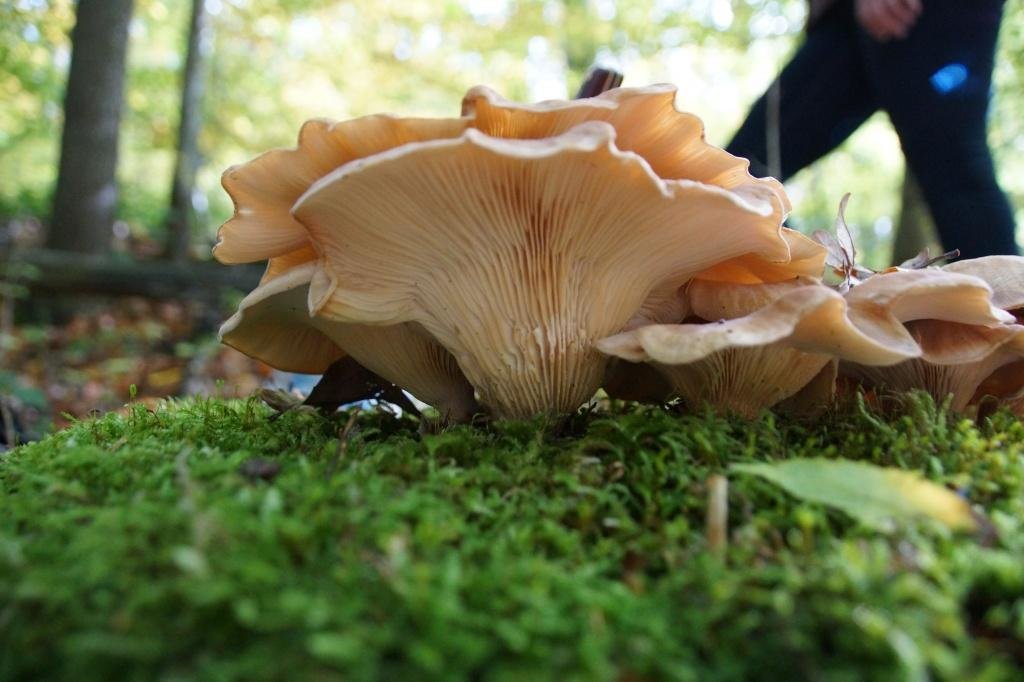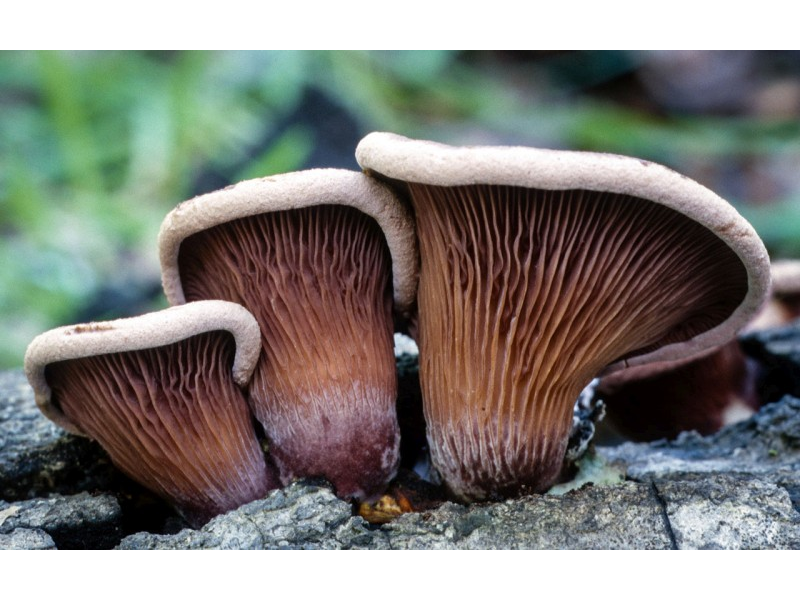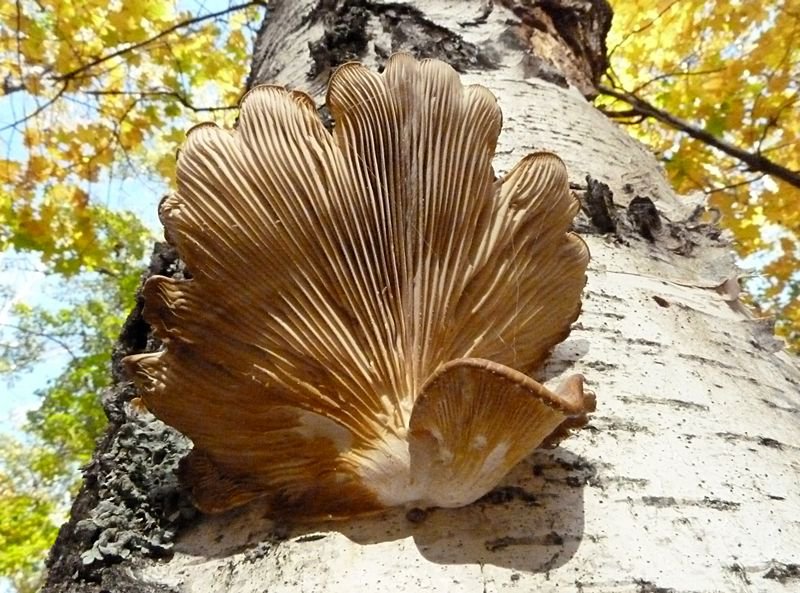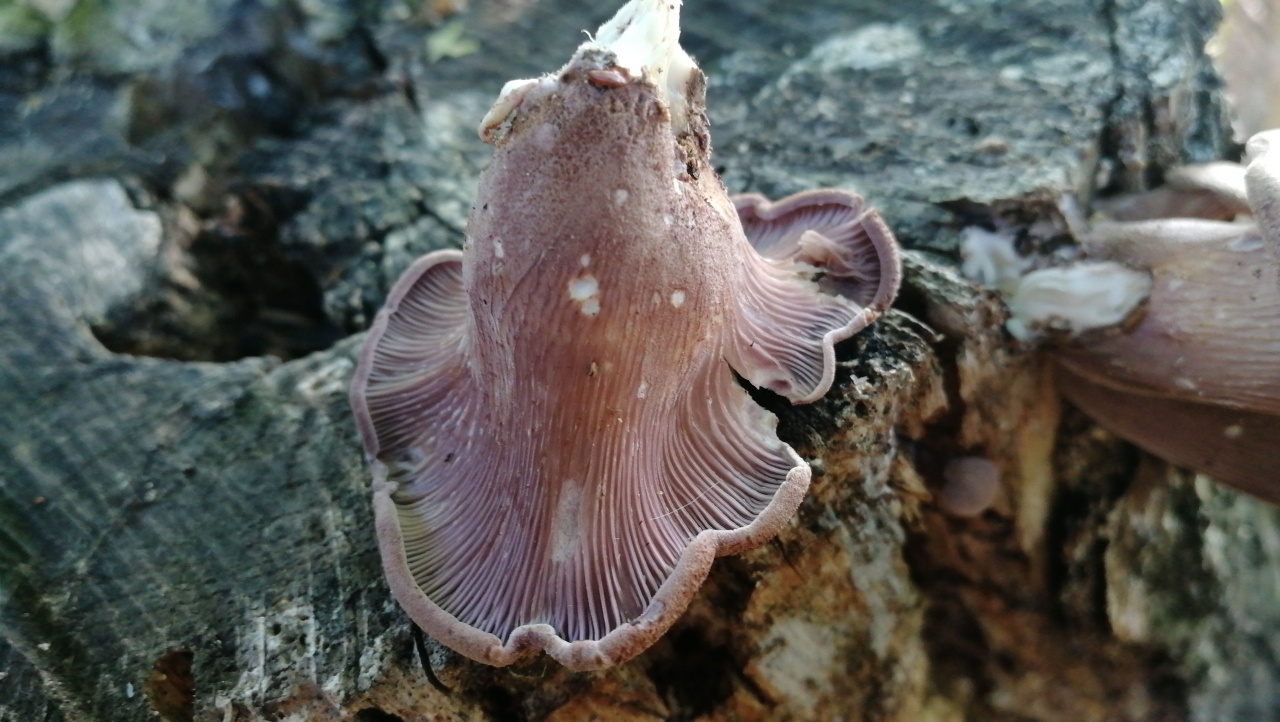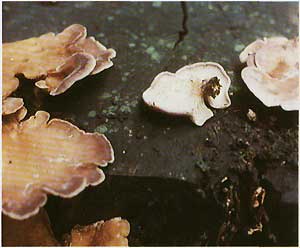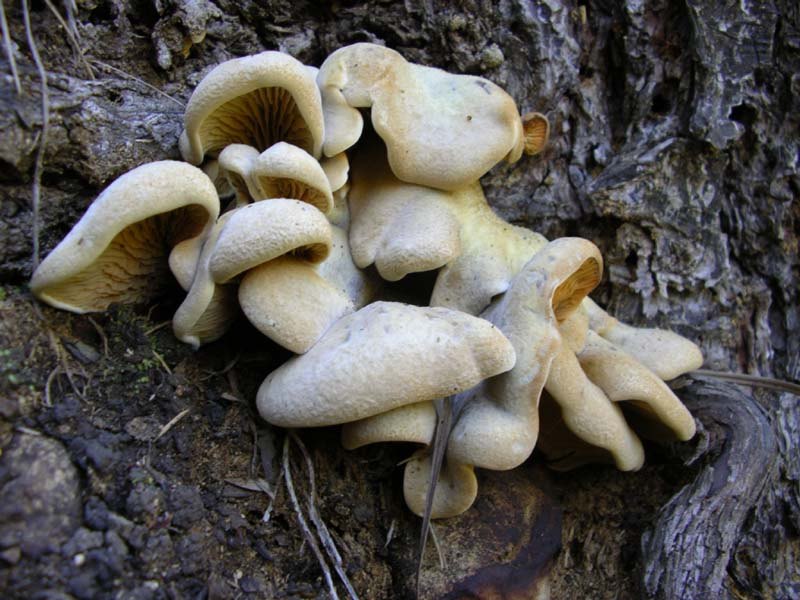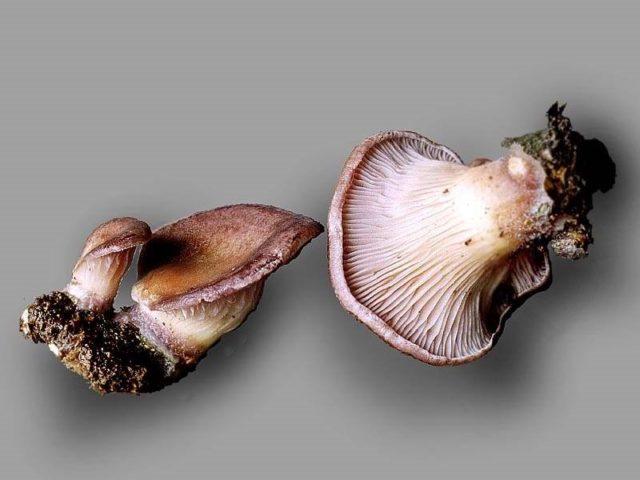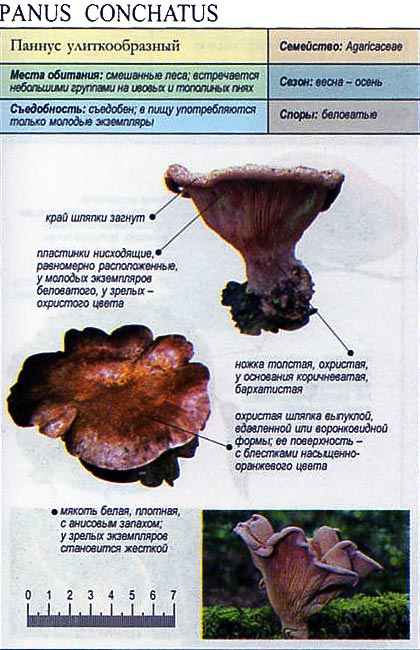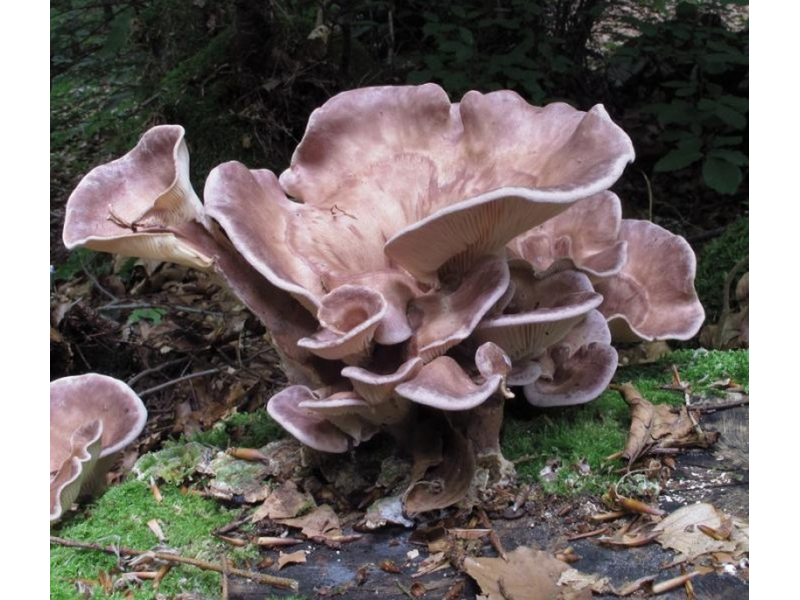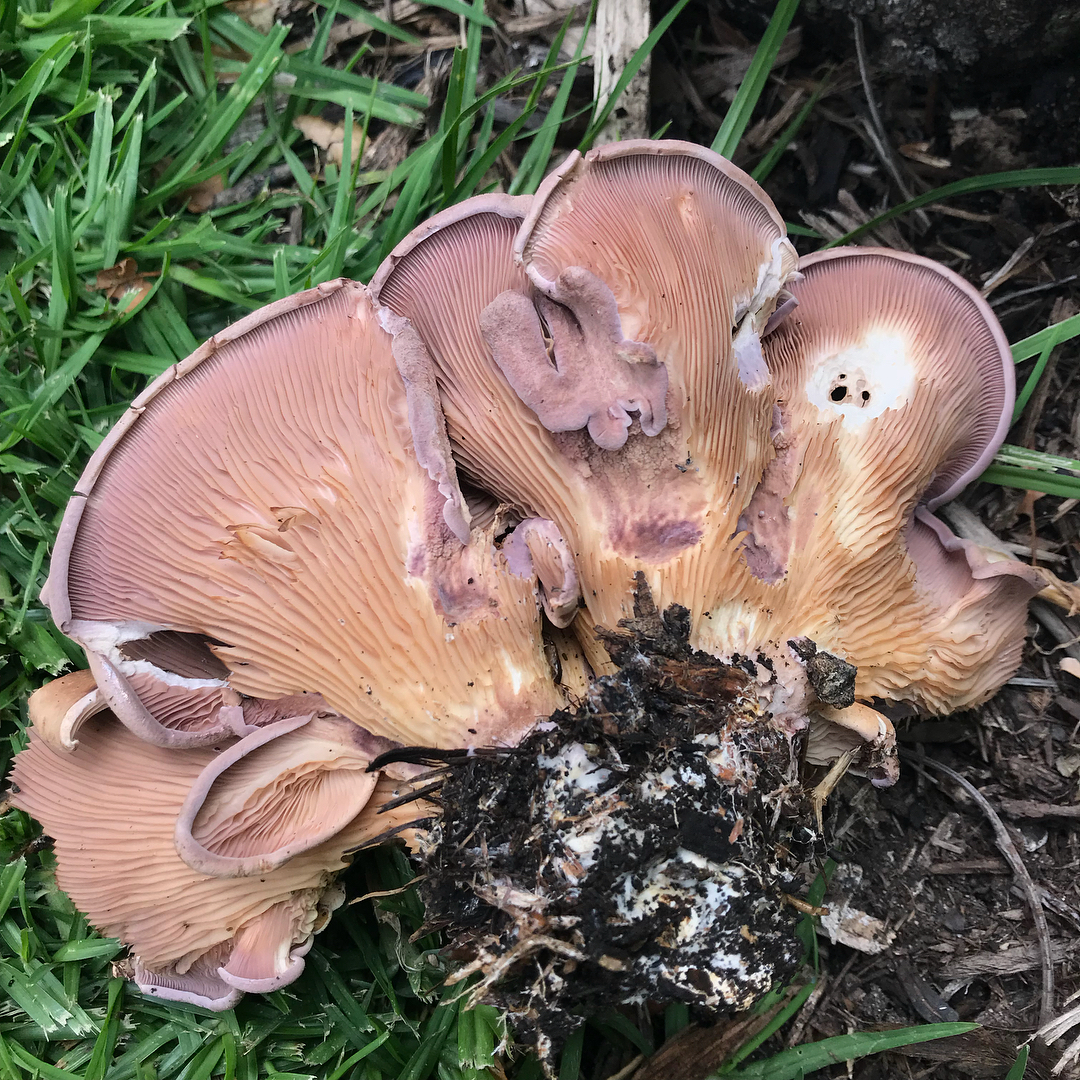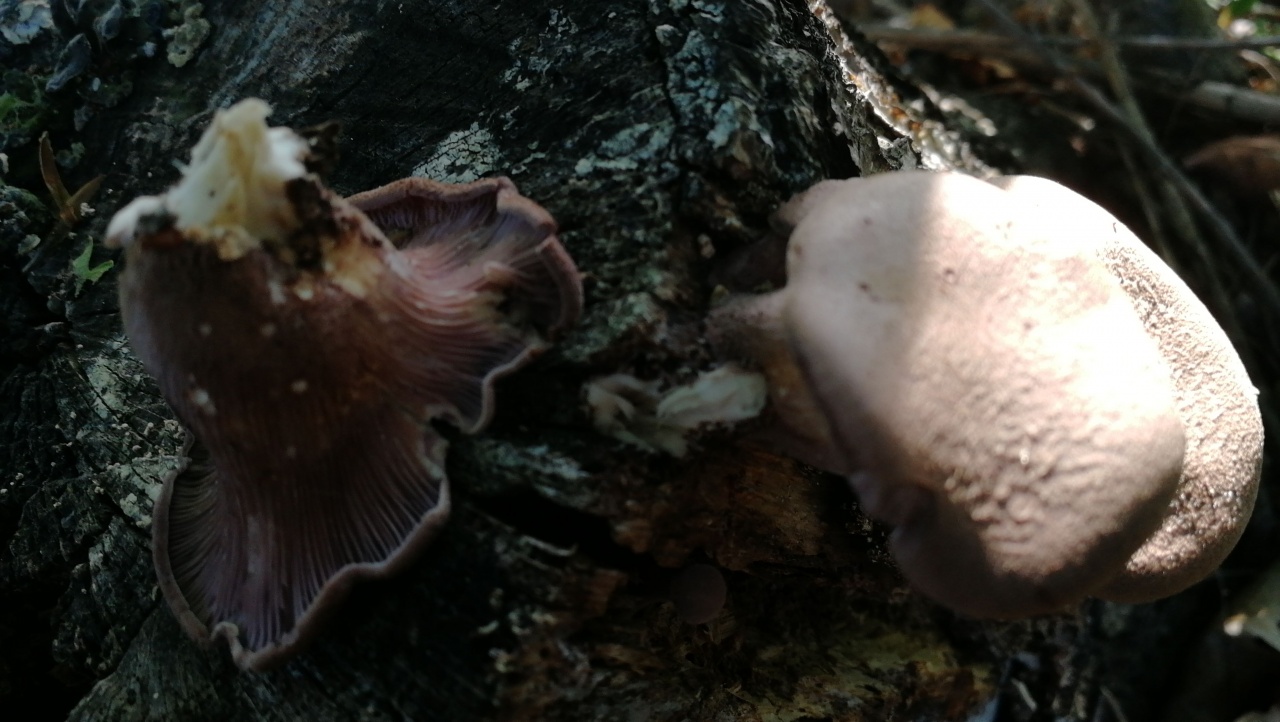Description
The cap is 5 to 15 centimetres (2.0 to 5.9 in) in diameter, and is initially convex, but later flattens or becomes centrally depressed in maturity. The cap is tan, lilac or reddish-brown, and smooth (glabrous); in age the surface may crack into small flattened scales. The cap margin is inrolled and often has a wavy or lobed outline. The flesh is tough and whitish. The gills are attached in a decurrently (running down the length of the stem), and are narrow and often forked. The gills initially have a violet tinge, but later become an or reddish-violet. The stem is 2 to 3 centimetres (0.8 to 1.2 in) long and 1 to 3 centimetres (0.4 to 1.2 in) thick, roughly the same color as the cap, but covered with violet hairs; it is attached to the cap laterally, or off-center. The spore print is white.
Viewed microscopically, spores are elliptical, smooth, and non-amyloid, with dimensions of 5–7 by 2.5–3.5 µm. The pleurocystidia are either enlarged in the middle (ventricose) or enlarged and spherical at the tip (capitate); these cells have dimensions of 35–45 by 8–11 µm.
Taxonomy
The species was originally described under the name Agaricus conchatus by French mycologist Jean Baptiste François Pierre Bulliard in volume 7 of his 1787 Herbier de la France.Elias Magnus Fries transferred it to the genus Panus in 1838.
The specific epithet conchatus is derived from the Latin word meaning "shell-like". It is commonly known as the lilac oysterling.
Panus conchatus mushrooms have an extremely variable morphology that changes with the age of the fruitbodies. Young specimens are pliable and fleshy, colored lilac to purple, and have a monomitic hyphal system (containing only generative hyphae). Old fruitbodies lose the coloring and develop a tough texture. They have a dimitic hyphal system, containing both generative and skeletal hyphae. Because of this variability in fruitbody morphology, the fungus has been described several times under different names by different mycologists. The following are heterotypic synonyms of Panus conchatus (based on a different type):
- Agaricus flabelliformis Schaeff. (1774)
- Agaricus carneotomentosus Batsch (1783)
- Panus monticola Berk (1851)
- Panus vaporarius Bagl. (1865)
- Lentinus percomis Berk. & Broome (1875)
- Lentinus divisus Schulzer (1879)
- Lentinus bresadolae Schulzer (1885)
- Lentinus carneotomentosus J.Schröt. (1889)
- Lentinus obconicus Peck (1906)
Doubles and their differences
In the forests, you can confuse a mushroom with an oyster mushroom. It differs from Panus ear-shaped in color, depending on age, the cap changes color from white to gray-ocher. The leg of the double is pronounced, reaches a length of 8 cm. Oyster mushroom is suitable for eating. The harvested crop can be eaten fresh, pickled.
It has an external resemblance to the ear-shaped pannus and the oyster mushroom is pulmonary. It is distinguished by a large cap, reaching 15 cm in diameter, of a light, whitish-gray shade. As the oyster mushroom grows, its color changes to yellowish. The shape of the cap is fan-shaped, the edges are directed upwards. The fruit body is edible, it grows in deciduous forests.
Panus ear-shaped and with oyster mushroom (lumpy) are similar in appearance. The hat with a diameter of 5 to 15 cm is funnel-shaped with rolled edges. The shade of this representative is the most diverse: in the forests there are specimens of a light ash, gray and yellowish hue. The mycelium is located on dead trees, outwardly it is a multi-tiered structure. The mushroom is often cultivated for industrial purposes.
References
- ^
- ^ Pegler DN. The genus Lentinus... A world monograph... Kew Bulletin Additional Series. 10... London, UK: Her Majesty's Stationary Office. pp. 134-136. ISBN 978-0-11-242627-1.
- Baglietto F. (1865). Materiali per la Micologia italiana. Commentario della Società Crittogamologica Italiana (in Italian). 2 (2): 261–265.
- Schröter J. (1885). Kryptogamen-Flora von Schlesien (in German). 3-1 (1). Lehre, Germany: Cramer. p. 554.
- ^
- ^ Orr DB, Orr RT (1979). Mushrooms of Western North America... Berkeley, California: University of California Press. p. 251. ISBN 0-520-03656-5.
- ^
- Mo JL, Fu SY, Zhan HY (2006). "Improving laccase activity of Panus conchatus by mutagenesis and used for biobleaching ". Transactions of China Pulp and Paper. 21: 29–33.
- Ding S, Wang J (2012). "Preparation of immobilized Panus conchatus bio-balls for fur dye wastewater ". Proceedings of the 2012 Second International Conference on Electric Technology and Civil Engineering... Washington, DC, USA: IEEE Computer Society. pp. 2005-2009. ISBN 978-0-7695-4704-6.
Description
Panus ear-shaped (Sawfoot ear-shaped), lat. Panus conchatus (Lentinus torulosus).
Hat with a diameter of 4 - 10cm. In young mushrooms, the surface of the cap is purple-red, but then turns brownish. The mature mushroom turns brown. The cap has an irregular shape: shell-shaped or funnel-shaped. The edges of the cap are wavy and slightly curled. The surface of the cap is hard, bald, leathery. In the ear-shaped pannus, the color and shape of the cap may differ. Young specimens have a characteristic color with a lilac tint. A young mushroom can be easily identified by this very characteristic.
The plates are rather narrow, not frequent, as well as the cap are hard. In a young fungus, the plates have a lilac-pinkish color, then turn brown. They descend along the stem. Powder of spores of white color. The stem is very short, strong, narrowed at the base and in relation to the cap is almost in a lateral position. Height 5cm, thickness up to 2cm. White pulp, hard and bitter in taste.
It is found in deciduous forests, usually on dead wood. The mushroom grows in whole bunches. Fruiting all summer and autumn. Panus ear-shaped is little known, but not poisonous. The mushroom will not bring any harm to the person who ate it. It is eaten fresh and pickled. In Georgia, this mushroom is used in cheese-making. Sometimes panus ear-shaped is mistaken for ordinary oyster mushroom. It is grown at home and in large farms, like oyster mushroom, according to the instructions for wood-destroying mushrooms. High-quality mycelium is the key to a good harvest.
The mycelium of wood-destroying fungi is available in two types: 1. Mycelium (mycelium) is live fresh primary grain in a transparent blister / zipper with a size of 8x12x3cm and weighing 120 - 150 grams (depending on the humidity of the environment; after all, it is alive, develops, breathes, gains and loses moisture).Shelf life is 6 months. at a temperature of + 2 + 6 ° С or 1 month at temperatures up to + 23 ° С without direct sunlight. It can withstand a higher temperature for 10 - 14 days, if the packages are not tightly in contact with each other. 2. Mycelium (mycelium) biologically dried primary grain 100g in a transparent blister / zipper package 8x12x3cm. The shelf life is not limited.
Instructions for growing wood-destroying mushrooms
Instructions for growing wood-destroying mushrooms on plant residues in bags (intensive method) 1. Place a homogeneous substrate (for example, only straw) or combined in any proportion of two or more components (for example, straw + hay + sawdust) in a container and pour boiling water. 2. Allow the steamed substrate to cool naturally to room temperature. 3. Squeeze well and mix thoroughly with mycelium (1 pack per 40 kg of moistened substrate). 4. Place in a plastic transparent bag, crushing slightly. Tie. 5. For air exchange, make several cuts of 3 - 5 cm across the entire area of the bag. 6. The result is a ready-made mushroom block. Place the blocks indoors or in a shady place in the garden in different ways, but it is better to hang them. During the germination period (3 - 4 weeks), light is not required. First, fluff is observed, then the substrate will take on a white or slightly yellowish color and turn into a dense block. 8. After another 1.5-2 weeks. the rudiments of fruit chalk appear. Light is already required 9. In those places of the rudiments of the fruiting bodies, cuts are made in the film. Fruiting takes place in waves in 2-3 weeks. between them. The first 2 waves bring the greatest yield.
Instructions for growing wood-destroying mushrooms on deciduous non-rotten wood (extensive method) 1. Bars, logs, pieces, etc. can be of any size, but preferably 30 - 40 cm long and 25 cm in diameter. They are soaked in water for a week. Freshly sawn ones can not be soaked or 1 - 2 days. 2. Holes are drilled or filed in the bar, mycelium is introduced (1up per 40kg), the holes are sealed with adhesive tape or laid with straw, or plugged with a cotton / paper swab, or covered in another way. 3. The period of mycelium overgrowth is 3 - 6 months. at t + 7 + 27.4. Placed in a shady place in the garden or in a ventilated area. 5. Harvesting - 1 - 2 times in the spring and 1 - 2 times in the fall, it is possible that there will be a harvest in summer under favorable climatic conditions.
More detailed instructions (+ instructions for growing and other mushrooms by species) in the brochure will be sent along with the order. Free consultations after the sale before the appearance of the first mushrooms when ordering from 5 packs. Mycelium will be sent after partial or full payment. With 100% payment - a bonus from the manufacturer!
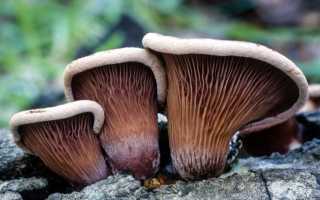
Taksonomi
Türler başlangıçta edildi anlatılan adı altında Agaricus conchatus Fransız mikelog tarafından Jean Baptiste François Pierre Bulliard yaptığı 1787 hacmine 7’de Herbier de la France ... Elias Magnus Fries cins devretmiş Panus 1838 yılında.
Belirli bir sıfat conchatus türetilir Latince "kabuk gibi" anlamına kelime. Bu edilir yaygın lila oysterling olarak da bilinir.
Panus conchatus mantar son derece değişken olması morfolojik fruitbodies yaşı ile değiştirir. Genç numuneler mor esnekti ve etli, renkli leylak ve monomitic sahip hif sistemi (yalnızca üretici hif ihtiva eder). Eski fruitbodies renklendirme kaybeder ve zor bir doku gelişir. Onlar üretken ve iskelet hem hifaları içeren bir dimitic hifal sistemi var. Çünkü fruitbody morfolojisi bu değişkenlik, mantar farklı mycologists tarafından farklı isimler altında birçok kez tarif edilmiştir. Heterotipik şunlardır eş arasında Panus conchatus (farklı göre Çeşidi):
- Agaricus flabelliformis Schaeff. (1774)
- Agaricus carneotomentosus Batsch (1783)
- Panus monticola Berk (1851)
- Panus vaporarius Bagl. (1865)
- Lentinus percomis Berk. Ve Broome (1875)
- Lentinus divisus Schulzer (1879)
- Lentinus bresadolae Schulzer (1885)
- Lentinus carneotomentosus J.Schröt. (1889)
- Lentinus obconicus Peck (1906)
Açıklama
Kapak 5 ila 15 santimetre çapında (5.9'a 2.0 inç) ve ilk olarak dışbükey olan, ancak daha sonra düzleştirir ve olgunlukta merkezi depresif olur. Kapaktır açık kahve renkli, leylak (ya da, kırmızımsı-kahverengi ve pürüzsüz tüysüz); yaş yüzey küçük yassı ölçekleri çatlayabilir. Kap marjı ise Form olarak içe dönük ve genellikle dalgalı veya loblu çevre çizgisine sahiptir. Eti sert ve beyazımsı. Solungaçlar bir decurrently (sapının uzunluğu boyunca çalışan) 'de bağlı ve dar ve genellikle çatallı olan edilir. Solungaçları başlangıçta mor belirti var, ancak daha sonra bir veya kırmızımsı-mor olur. Kök kalın uzun 2 ila 3 cm (1.2 ile 0.8 arasında) ve 1 ila 3 cm (1.2 0.4), yaklaşık olarak aynı kapak renk, ancak mor tüyleri ile kaplı olduğu; yanal kapak bağlı ya da merkez dışı bir. Spor baskı beyazdır.
Mikroskobik bakıldığında, sporlar, eliptik, pürüzsüz ve dışı olan amiloid 2.5-3.5 göre 5-7 boyutlarında, um. Pleurocystidia ya orta (genişletilir ventricose ) ya da uç (büyütülmüş ve küresel kapitat ); Bu hücreler, 8-11 um ile 35-45 arasında boyutlara sahiptir.
Panus auricular (Sawfoot auricular, Panus conchatus): what it looks like, where and how it grows, edible or not
The cap is 5-10 (15) cm in diameter., Fleshy in the center, at first convex-outstretched with a tucked edge, eventually becomes depressed, funnel-shaped, lingual, ear-shaped, conch-shaped, with a sinuous lobed edge, the surface is dry, radially fibrous, fluffy or fine-scaly, at first lilac-brown, later fading to yellowish-brown, yellowish-beige, often with a wine or purple tint.
The stalk is usually short, but rather well defined, dense, stiff, eccentric, sometimes lateral, often tapering towards the base, 1-2 cm in height, 0.4-1 cm in thickness, fibrous, bristly or pubescent, especially at the base, at first lilac-brown, later fades to beige-brown, often with a lilac tint.
The plates are descending, wavy, frequent, wide and thin, at first whitish, later yellowing, buffy, sometimes with a purple tint
The pulp is white, dense, leathery, with a pleasant smell and sweetish (Wasser) or bitter (latvijasdaba) taste.
Spore powder is white.
Spores are cylindrical, colorless, smooth, 5-6x3-4 microns
Grows in groups, often accrete at the base of the legs, on stumps and trunks of pines, in December-March
Little-known mushroom edible at a young age (Wasser).
A similar species is Tapinella panus-shaped, characterized by the frequent absence of a leg, smaller size, brownish spore powder and the absence of purple and wine tones in color.
הכובע בשרני במרכזו, בתחילה קמור-שטוח ושוליו מקופלים, אחר-כך נעשה שקוע או משפכני, דמוי לשון, אוזן או צדף וגלוםיו קוטרו 5-10 (15) ס32מ, פניו יבשים, סיביים, לבדיים או קשקשיים במקצת, צבעו בתחילה חום-סגלגל, אחר-כך חום-צהוב עד יויו
הרגל בדרך כלל קצרה אך ניכרת, מוצקה, קשה, צדדית, לעתים צרה בקרבת הבסיס, גובהה 1-2 סתמ, עוביה 0.4-1 ססתמ, סיבית ו, יתבתמ, סיבית ו, יפניתתממ, סיבית ו , אחר-כך חום-בז ', לעתים בגוון סגלגל
הדפים גולשים, גליים, צפופים, רחבים ודקים, בתחילה לבנבנים, אחר-כך מצהיבים, צהובים-עכורים או קינמוניים, לפעולפעמים
הבשר לבן, מוצק, גלדני, ריחו נעים וטעמו מתקתק (ואסר) או מריר במקצת (latvijasdaba)
אבקת הנבגים לבנה
הנבגים גליליים, חסרי-צבע, חלקים, גודלם 5-6 על 3-4 מיקרון
הפטריה גדלה בקבוצות, בהן גופי הרביה לעתים מחוברים בבסיסי הרגליים, על גזעים כרותים של אורנים, בדצמבר-מרס

